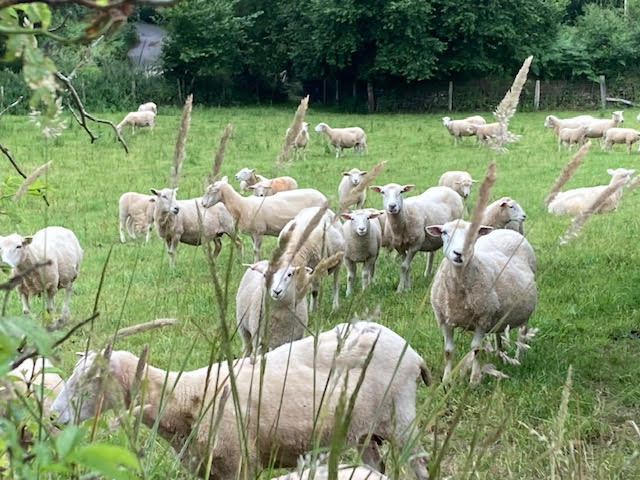I am in the Pound. The Pound at Shallowford.
It was built as a solid stone enclosure four feet high, near to the entrance to the farm, for stray animals, where they were held until a local farmer came to claim them.
It was restored through a grant from ‘Moor than meets the eye’. It is now a quiet place. Almost a garden of retreat.
A chapel in nature and perhaps one day we will use it thus.
The choir is readily available as the sheep and lambs are bleating continuously about family and belonging. The chaffinches are singing in the pig barn about food and provision; and if only they will be quiet for a minute, I will hear the sweet song in the hazel of the wren and blue tit and sparrow with their chorus of ‘Let everything that had breath praise the Lord.’

From nearer the house comes the busy whispers of the martens, the baritone croak of a crow and the cackle of a jay.
There is percussion, too, with the rolling of the river in the distance, but nearer the tush of the wind in the trees. Ever so quiet and building to a swaying rush oak bough waving crescendo. There is the promise of rain as grey clouds fill the sky.
A bee joins in and buzzes off.
‘Let everything that has breath praise the Lord.’
The shape of this chapel is neither cruciform nor rectangular, but more spherical with a flat bottom end. It is a natural shape. It is the way it is kind of shape. Solid granite walls, four or so stone high, and built into a thick bank. The stones are dressed with moss, light green, dark green.
For stained glass windows there are foxgloves like a line of small pink bells; and pink campion as if delicately painted growing out of the walls, amidst the long fingers of the ferns and cream flowers of the prickly bramble.
They tell a story not of saints gone by, but their creator God.
‘Let everything that has breath praise the Lord.’
For the higher walls above the stone work is all green canopy. Hazel mostly, growing all around. A tall rambling holly stands at one side like a pillar, and an oak tree leans over high, and stretches as if half a roof structure.
For flagstones there is green grass. For pews there is one bench.
For oak entrance door there is a small gate, that as I passed this morning was wide open as if to say welcome. As if perhaps to sign, come, now is the time to worship, come, now is the time to praise our God.
There is no altar or table. Only a crab apple tree, whose fruit like the sacrament is shared with the nearby grunting congregation of pigs in season.
There is a bird box installed this year, too early to have provided a nest; but perhaps might later echo the words of the Psalmist: ‘even the bird had found a home for herself, a place near your altar O Lord Almighty, my King and my God.’
At the far end of this chapel are six stone steps cut into the wall. It is a way out to the lane, but with difficulty. It is a stairway overgrown by hazel. Perhaps it is like Jacob’s stairway to heaven, which made him say of that place: this is none other than the house of God. This is the gate of heaven.
There is no roof in this chapel save the sky, which yesterday was blue, today is grey and tomorrow who knows.
It was Solomon who said of his grand temple that it couldn’t possibly contain the Almighty, and so it is here. It is a small quiet space that can remind us of He who is far greater than our imaginings.
And this: Let everything that has breath praise the Lord.

